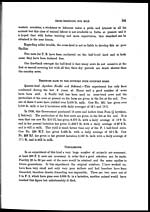Medicine - Veterinary > Veterinary colleges and laboratories > Indian journal of veterinary science and animal husbandry > Volume 3, 1933 > Original articles > Cross-breeding for milk
(422) Page 332
Download files
Individual page:
Thumbnail gallery: Grid view | List view

332 THE INDIAN JOURNAL OF VETERINARY SCIENCE AND ANIMAL HUSBANDRY [ III, IV.
When the calves of these F. 2 and F. 3 go onto ordinary rations from milk
ration, they appear to fall away for a few months and after a year old they begin
to pull up again, but they do not as a whole grow or look so well as the Sindhi
heifers at the same age. In many cases the coats of calves are rough looking and
they have tight skins but these improve as the animals grow. Ringworm has been
very bad at Hosur for the last 4 or 5 years and animals attacked with this disease
become run down and it takes a long time to get them back into condition again.
These half-bred calves have not been pampered, they have been fed on the same
fines with the country calves and young stock, and if they could not survive they
have had to go under.
Adult cows on the whole look well, they are not too big and are about the
proper size for a small dairyman. The bulls are disappointing, the chief fault in
the F.2 and F.3 animals is that they are weak in their hind legs, when viewed from
the rear, their hocks almost touch one another, the forepart of the bull is generally
good, a large strong neck with a good chest capacity, although in some cases some
of the bulls appear to fall away behind the shoulder. Almost all cross-bred bulls
are very quick and good at service.
Colour.
The colours of each generation are generally as follows:—
F.1 are black, dark-brown, black and white and occasionally brown and
white and brindle.
In the F.2 the animals are mostly reds, light brown and red and white.
In F.3 and F.4, light red, red and white with occasional fawns and black
and white. Most of them have smooth coats when adults.
Disease resistance.
From my experience in the last 12 years, I find that the half-bred stands up to
disease such as foot-and-mouth disease, just as well as the country animal.
Amongst the country cows there have been worse and longer cases than amongst
the half-breds. Regarding rinderpest, I do not think there is much to fear
provided the animals are regularly inoculated as calves and done again at the age
of 3 years by the S. S. method. Some of the cross-bred calves have died from
rinderpest reaction, others have been used as controls and have survived. As
calves, the animals appear to suffer from stomach trouble much more than the
suckling calves. In my opinion, this is chiefly due to hand-feeding. In most
Set display mode to: Large image | Zoom image | Transcription
Images and transcriptions on this page, including medium image downloads, may be used under the Creative Commons Attribution 4.0 International Licence unless otherwise stated. ![]()
| Permanent URL | https://digital.nls.uk/75230743 |
|---|
| Description | Covers articles from 1933. |
|---|




